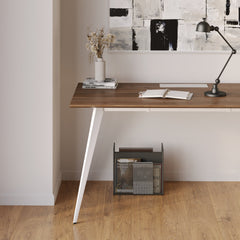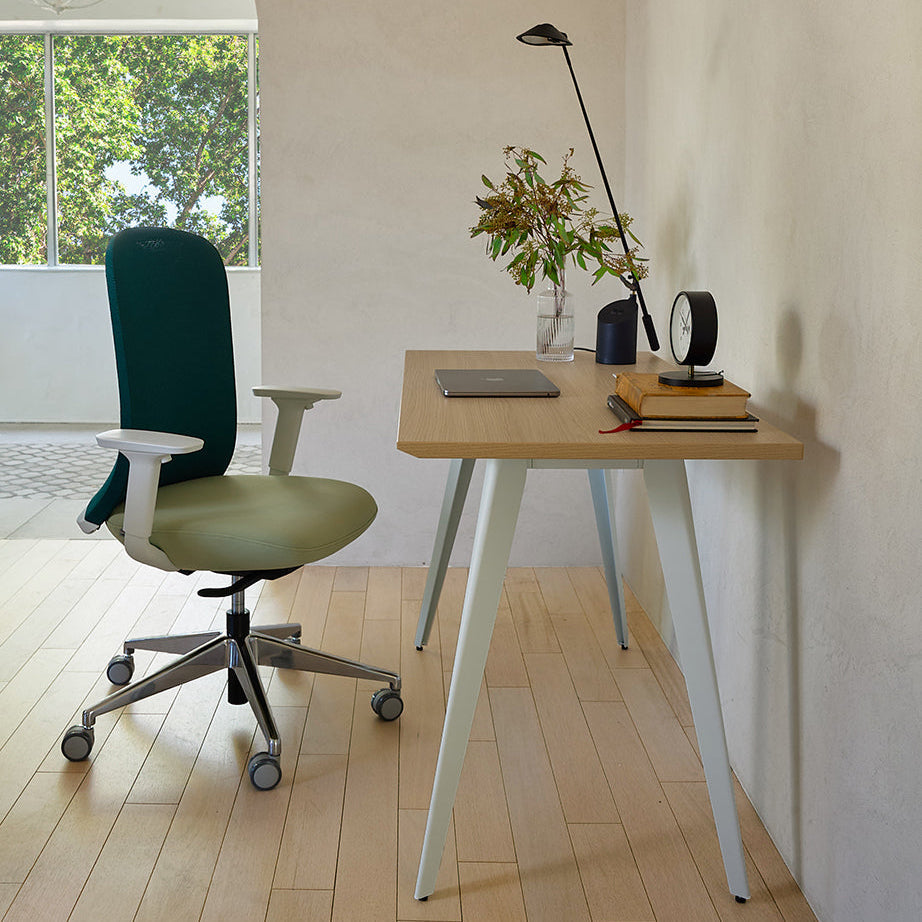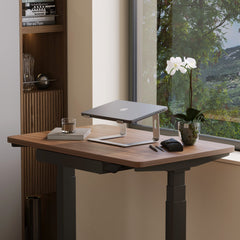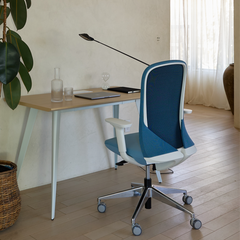Get 10% off your first order
Find the office furniture that’s designed to match your style, comfort, and needs perfectly. Subscribe
Boundary Work From Home Setup: How to Define Your Home Office Zone

Visit quiz page to see how we makes it easy to create an inspiring workplace


Have you ever wondered why some days you can achieve hours of deep focus, while other days, your attention seems to slip after just a few minutes? The secret often lies not in your willpower, but in your physical environment. Your desk setup is more than just a place to put your computer; it is a meticulously designed ecosystem that directly influences your brain chemistry, mood, and capacity for sustained concentration. When your setup is optimized, your brain conserves energy that would otherwise be spent battling distractions or physical discomfort.
The science behind focus reveals that our brains thrive in predictability, comfort, and minimal sensory friction. A poorly designed desk creates constant, low-level stress—a wobbly monitor, a cramped posture, or visual clutter—which constantly fragments your attention. This phenomenon, known as cognitive load, steals energy from the analytical and creative centers of the brain. By intentionally designing your workspace, you are actively supporting your neurological function, turning your desk into a powerful tool for productivity.
A workspace that supports deep work operates on principles of environmental psychology and ergonomics. Every decision, from the height of your chair to the color of your walls, is a factor in maintaining a state of flow. Our goal is to make the physical body disappear into the background so that the mind can focus entirely on the task at hand. This transformation from a simple table to a command center is key to unlocking peak performance.
To achieve this state of effortless focus, the first step is ensuring you have the ability to adapt your posture. Investing in versatile furniture is essential for any modern worker. A height-adjustable standing desk allows you to alternate between sitting and standing, a crucial practice for maintaining high energy levels and preventing the stiffness that breaks concentration.
Concentration is profoundly physical. When your body is uncomfortable, your mind cannot truly be focused. Poor posture restricts blood flow, reduces oxygen intake, and places constant strain on muscles, resulting in pain that continuously demands the brain's attention. Eliminating this physical friction is the primary goal of ergonomic design.
When you slouch, the natural S-curve of your spine flattens. This puts immense pressure on your intervertebral discs and accelerates fatigue. An ergonomic setup ensures your body maintains a neutral, supported posture, allowing the muscles to relax and circulation to flow freely. This conserved physical energy is redirected to cognitive tasks.
The body's alignment must meet these specific angles for sustained, pain-free work:
Feet Flat: Ensure your feet rest flat on the floor or a footrest, with knees bent at about a 90 to 100-degree angle.
Elbows at 90 Degrees: Your elbows should be level with the desktop when your arms are resting, allowing your wrists to remain straight when typing.
Lumbar Support: Your chair must support the inward curve of your lower back, preventing the pelvis from tilting backward and causing the spine to slump.
Shoulders Relaxed: The arms must be supported by armrests set at the proper height so the shoulders do not shrug up toward the ears, eliminating neck tension.
A workspace built around proper ergonomic alignment is a non-negotiable prerequisite for deep work.
The principle "clear desk, clear mind" is scientifically sound. Visual clutter—piles of papers, tangled cables, or unorganized tools—forces your brain to continuously process irrelevant stimuli. This hidden effort reduces your working memory capacity, leaving less mental bandwidth for creative problem-solving. A minimalist approach is about managing the visual field to reduce cognitive friction.
Studies in cognitive psychology demonstrate that visual clutter directly competes for the attention of the brain's object recognition system. This means your brain is perpetually distracted by the mess, whether you realize it or not. A minimalist desk setup is an intentional act of sensory reduction that frees up neural resources.
To effectively control visual friction:
Implement Zonal Storage: Assign every item a home, utilizing drawers or closed containers to hide non-essential items completely.
Hide Cabling: Cables are a prime source of visual chaos; use trays or sleeves beneath the desk to make them invisible from the work position.
Limit Surface Décor: Only one or two emotionally resonant items (like a plant or photo) should be allowed on the primary desktop.
A premium modern office desk with clean lines and integrated storage can anchor this minimalist approach. By maximizing surface area for working while offering seamless solutions for storing peripherals and documents, these desks naturally promote a clutter-free environment.
Light is the single most powerful environmental factor affecting your circadian rhythm, the internal clock that regulates wakefulness and sleep. Poor lighting can induce eye strain (visual fatigue) and disrupt hormone production, making you feel sluggish long before your actual workday should end. Strategic lighting maintains high energy and focus throughout the day.
Natural daylight, particularly blue-spectrum light, signals to the brain to suppress melatonin (the sleep hormone) and produce cortisol (the alertness hormone). Positioning your desk near a window, ideally perpendicular to the light to avoid glare, is the most effective way to leverage this natural booster.
Lighting Strategies for Focus (Enumeration):
Maximize Daylight: Keep window coverings open during working hours to maintain high alertness.
Layer Lighting: Use a combination of soft overhead (ambient) light and focused task lighting to eliminate shadows.
Control Glare: Position monitors and task lamps to ensure no light reflects directly into your eyes.
Use Warm Tones at Night: Switch to warmer, dimmer light sources in the evening to prepare your brain for sleep.
Task lighting is crucial for precision. It illuminates a small area brightly, reducing the contrast between your desk surface and your monitor. This reduction in contrast minimizes the continuous effort your pupils must make to adjust, which is a major, often overlooked, source of eye fatigue.
The human body is designed to move, not to remain static for eight consecutive hours. Prolonged sitting, even in an ergonomically perfect chair, restricts circulation and leads to muscle fatigue. This physical stagnation is a major contributor to the mid-afternoon energy crash that severely undermines concentration.
An effective focus strategy must be dynamic, encouraging frequent, subtle shifts in posture. The ability to transition between sitting and standing, or even just shifting weight, actively pumps blood and oxygen, keeping the brain alert and preventing musculoskeletal pain.
|
Posture Duration |
Action Required |
Physiological Benefit |
|
45-60 minutes |
Change from sitting to standing (or vice versa). |
Boosts circulation; prevents muscle shortening. |
|
20 minutes |
Micro-adjustment of chair tilt or height. |
Redistributes pressure points; reduces localized fatigue. |
|
Every 90 minutes |
Walk away from the desk for 5 minutes. |
Full body reset; cognitive restoration. |
For small offices or home setups, mobility is paramount. For smaller office setups, a well-placed, compact desk solution is essential. In fact, a specialized Small Standing Desk Kansas ensures you get the full ergonomic benefit of height-adjustability without consuming excessive floor space, making the dynamic workstation achievable anywhere.

Visual fatigue is one of the quickest ways to induce overall mental exhaustion. If your monitor is too high, too low, or too close, your neck muscles and eye muscles are constantly strained. This is where the precise placement of peripherals, often using specialized supports, comes into play.
Maintaining a neutral neck and spine position requires the monitor to be perfectly aligned with your eye level and distance. Any deviation forces muscles to remain contracted, leading to headaches and fatigue that steal focus.
Monitor Distance: The screen should be positioned roughly an arm's length away (20 to 30 inches) to minimize the need for the eye lens to constantly adjust.
Monitor Height: The top of the display screen should be at or slightly below eye level, encouraging a slight downward gaze which is most restful.
Input Alignment: The keyboard and mouse must be close enough to keep the elbows at the sides of the body.
The placement of your monitor and input devices should be highly customizable. This level of adaptability is often achieved with high-quality supporting hardware. A precision ergonomic monitor arm ensures your screen is positioned exactly at eye level and at the correct viewing distance, preventing neck strain and making it easier to maintain the neutral posture necessary for sustained focus.
Acoustic distraction is perhaps the most immediate enemy of deep work. The human brain is particularly sensitive to sudden, unpredictable, and conversational noise. The cognitive energy required to filter out this background chatter is enormous, often leading to rapid mental burnout.
Since we cannot eliminate all noise, the goal is to control the environment to minimize the disruptive impact of sound. The focus is on reducing the intelligibility of background sounds, which is what the brain finds most distracting.
Sound Absorption: Use soft furnishings like rugs, heavy curtains, and upholstered chairs to absorb sound waves and reduce echo.
Sound Masking: Employ gentle, non-intrusive sound masking (like nature sounds or brown noise) to neutralize the intelligibility of sudden noise.
Strategic Placement: Position the desk away from high-traffic areas, windows facing busy streets, or kitchen zones.
Material Selection: Hard, reflective surfaces (bare walls, glass, metal) should be minimized near the work zone.
This multi-pronged approach to acoustic ergonomics protects the prefrontal cortex, the area of the brain responsible for executive function and concentration, from auditory overload.
Even when working in teams, periods of individual deep work are necessary. Designing a collaborative workspace that respects the need for focus is a complex, yet achievable, challenge. The furniture must be adaptable enough to support both spontaneous interaction and heads-down productivity.
In shared or open-plan offices, furniture can be used to create "visual and acoustic barriers" without resorting to high walls. This requires using the furniture itself to subtly define territory and control sightlines.
Strategies for Shared Focus (Checklist):
☐ Provide generous individual surface area within a shared footprint.
☐ Ensure integrated cable management to prevent group clutter.
☐ Use adjustable height desks to allow for individual postural control.
☐ Incorporate sound-dampening materials near workstations.
☐ Use low screens or panels to provide visual privacy without isolation.
For teams that require flexibility in their work style, a customizable two-person standing office desk allows each user to maintain their own optimal ergonomic setting while co-working on a large shared surface. This enables simultaneous individualized focus and easy communication without sacrificing personal comfort or control.
Color is one of the most immediate stimuli in your environment, affecting mood, stress levels, and cognitive performance. Understanding the psychological impact of your office color palette is a crucial, non-verbal communication tool for your brain that influences alertness and emotional state.
The wavelength of light determines the physiological response. Cooler, shorter wavelengths (like blue) are often associated with calm and focus, while warmer, longer wavelengths (like red) are associated with stimulation and urgency.
Blue and Green: Associated with calmness, clarity, and efficiency. These colors are often preferred for analytical and creative tasks as they induce a state of relaxed focus.
Yellow and Orange: Stimulating and energetic, better suited for creative brainstorming or social zones, but can cause visual agitation if overused.
Neutrals (White/Gray): Promote simplicity and lack of distraction, acting as a clean backdrop for intense focus.
The goal is tonal balance: using calming base colors (neutrals, soft blues) on large surfaces, and reserving stimulating colors for small accents to prevent visual fatigue. A deep dive into the philosophy behind visual simplicity can be found by researching the cultural influence and principles of minimalism in interior design, which prioritizes clarity and function over ornamentation.
The best setup is one that stays optimized. Focus is a habit, and an organized desk supports this habit. Allowing clutter to creep back onto your desktop or letting your ergonomic settings slip will quickly erode all the initial benefits of your design investment.
Maintaining focus requires daily rituals that reinforce order and preparedness. These small actions minimize decision fatigue and reduce the mental friction of starting work each day.
Focus Maintenance Rituals (Table):
|
Time of Day |
Action |
Purpose |
|
End of Day |
Clear desktop of all non-essential items. |
Ensures a fresh start; prevents next-day cognitive load. |
|
Start of Day |
Adjust chair and monitor heights precisely. |
Confirms ergonomic alignment; sets a ritualistic boundary for work. |
|
Mid-Day |
Organize digital files and email inbox. |
Reduces visual clutter of the screen; clears mental space. |
|
Hourly |
Stand, stretch, or change posture. |
Combats static fatigue; maintains circulation. |
The final layer of maintenance is automation. Setting reminders on your phone or computer to stand up, adjust your gaze, or perform a two-minute declutter at the end of the day moves the responsibility from conscious willpower to automated habit, guaranteeing sustained consistency.

Ultimately, the science behind your setup relies on behavioral conditioning. When you consistently use your perfectly designed, clutter-free, and comfortable workspace only for high-value tasks, your brain begins to associate that environment with deep concentration. The mere act of sitting at your desk becomes a powerful trigger for focus.
This deliberate programming transforms your furniture and space into a cue that immediately shifts your brain into a high-performance, low-distraction mode.
Consistency: Use your desk exclusively for focused work. Avoid eating, watching entertainment, or handling non-work related matters there.
Sensory Cues: Use a specific, non-intrusive sound (like a certain playlist or ambient track) only when doing deep work. This audio cue acts as a mental switch.
Boundary Setting: Define a clear end-of-work ritual (e.g., tucking in the chair, turning off the task lamp) to signal your brain that it is time to switch off and conserve energy.
Aesthetic Discipline: Maintain the visual minimalism religiously; any deviation weakens the established "focus" signal.
This entire process creates a positive environmental feedback loop: a good setup leads to better focus, which leads to better results, which reinforces the desire to maintain the good setup. This sustained cycle is the ultimate goal of the science of the workspace.
Your capacity for focus is not fixed; it is a resource that can be grown and protected. The science is clear: the path to sustained concentration runs directly through your physical workspace. By viewing your desk not as a collection of furniture but as a sophisticated neuro-support system, you gain an immense competitive advantage.
Every deliberate choice—from eliminating visual clutter to supporting dynamic posture—is an investment in your cognitive longevity. When your environment actively supports your brain, you stop fighting distractions and start operating at your absolute peak. It is time to stop viewing comfort as a luxury and start recognizing optimized design as a performance superpower. Design your desk not for the work you do, but for the focus you deserve.

Boundary Work From Home Setup: How to Define Your Home Office Zone

Hidden Hazards: 5 Ergonomic Traps Derailing Your Remote Work

How to Stay Focused and Motivated While Working from Home
Get 10% off your first order
Find the office furniture that’s designed to match your style, comfort, and needs perfectly. Subscribe
Leave a comment